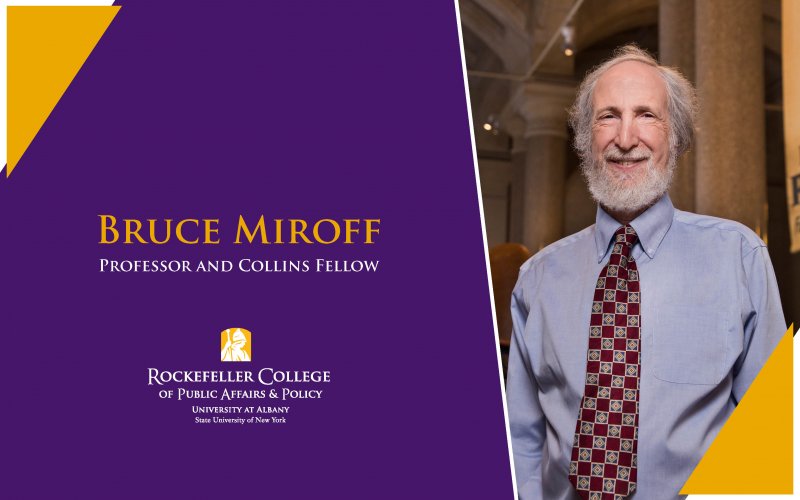Professor Bruce Miroff Retires from Rockefeller After 43 Years

When Bruce Miroff first arrived at the University at Albany, it was a bitterly cold February day. A thick layer of clouds overhead gave the city of Albany a bleak backdrop as he stepped off the plane from Austin, Texas into a blanket of snow. However, when he arrived on UAlbany’s campus that day for an interview in 1978, he was greeted with a warm welcome from his future colleagues in Rockefeller College’s Political Science Department. In search of like-minded faculty and supportive senior administrators, as well as a positive social environment to raise his one-year-old son, Miroff saw the potential in making Albany his home. That summer, Miroff moved his family to the Capital Region, and 43 years later, has never regretted it.
“In my 43 years at UAlbany, I'm most proud of the contribution I made to our students through my teaching,” reflected Professor Miroff. “Although it was not my favorite course to teach, the large introductory course on American politics that I've taught nearly every fall semester was the most important. With class sizes ranging from 250 to 470, I estimate I taught well over 10,000 students in this course.”
“I sought in the introductory course not only to provide a broad understanding of American politics and government, but also to guide our students into looking at familiar features of American political life with a fresh and more critical eye,” Miroff added. “Above all, I focused on an appreciation of democracy in all of its inspiring yet demanding ways.”
While earning three degrees from the University of California, Berkeley from 1962-1974, Miroff immersed himself in both the academic scene and the political scene on campus. “Berkeley, in the 1960s, was a place where ideas and political action were closely intertwined,” he explained.
Living through a tumultuous time in American history during a formative time of his life, Miroff became deeply involved in the 1960s civil rights movement. “Of all the activities in my life, I'm most proud of my participation in the civil rights movement when I was young,” Miroff stated.
After watching the March on Washington on television the summer after his freshman year at Berkeley, Martin Luther King, Jr.’s "I Have a Dream" speech inspired him to join a civil rights group upon returning to campus. He took part in protests and sit-ins in the Bay Area, and in the summer of 1965, he traveled south to register voters as Congress debated the Voting Rights Act.
“Taking part in a voting-rights project of the Southern Christian Leadership Conference, led by Dr. King, I worked with a fellow volunteer encouraging and assisting black citizens to register to vote in a rural area of South Carolina,” recalled Miroff. “Immersed in the struggle on the ground against segregation, I witnessed the dignity and courage of Americans, many low-income and poorly educated, in seeking their rights. It was an unforgettable experience that became the bedrock of my own democratic faith.”
Academically, Miroff’s choice to write his dissertation on the presidency of John F. Kennedy carved his niche and path for the rest of his academic career. Over the years, Miroff authored four books on presidential politics and American political leadership and co-authored six editions of a textbook for introductory courses in American politics, in addition to writing numerous journal articles and book chapters.
“It's hard for faculty members at a research university to find the right balance between teaching and scholarship. In seeking that balance, I'm proud of the scholarship I've produced,” said Miroff. “Rejecting the tendency to write only for fellow scholars in one's area of specialization, I've always tried to write books that could also appeal to general readers.”
Miroff’s Icons of Democracy: American Leaders as Heroes, Aristocrats, Dissenters, and Democrats (1993) was a selection of the Book-of-the Month Club and The Liberals’ Moment: the McGovern Insurgency and the Identity Crisis of the Democratic Party (2007) was a New York Times Editors' Choice.
During his time at UAlbany, including six years as chair of the Political Science Department, Miroff has witnessed firsthand the evolution of the University. “Over four decades, the demographics of the campus have changed. There are now more students of color, children of immigrants, and students who have to work in addition to taking classes,” observed Miroff. “I believe that this diversity creates a more enriching educational environment for all of us.”
Professor Miroff will officially begin his retirement on September 1st and earn emeritus status.
“For myself and my wife, Melinda Lawson, retirement is an open book,” said Miroff. “We want to travel more and see our grandchildren more often.”
In addition, Professor Miroff and Melinda, a historian, look forward to spending more time actively involved in the Humanities Institute for Lifelong Learning (HILL), a program that primarily serves senior citizens in their local Delmar, N.Y. community.
“It's a wonderful institution, bringing faculty members from UAlbany and other colleges in the Capital Region to teach many different disciplines and has attracted a large following,” said Miroff, who has taught in the program for two decades. “Now we are joining the board of HILL, on which we will take part in planning future HILL course offerings and managing the courses offered each fall and spring.”
Intellectual education and political education — the two pillars of his experience at Berkeley have continued to shape and guide Miroff throughout his academic career, and now, will follow him into retirement.
The University at Albany, Rockefeller College, and the Capital Region community are certainly glad Professor Miroff chose to make Albany his home on that frigid day in February, 43 years ago.


